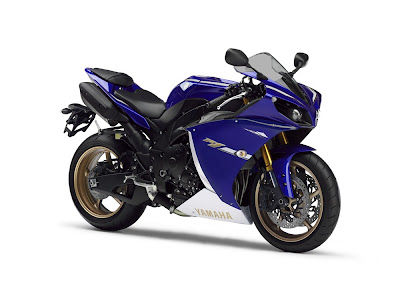
The 2012 Yamaha YZF-R1 comes with plenty of new styling cues, including a new upper fairing with a revised headlight cowl, giving the bike an aggressive and more modern styling cue. That’s complimented by new LED position lights, new hexagon-shaped muffler caps, and heat shields for a sharper profile at the rear. The footrests have been redesigned for great boot sole contact and advanced rider/motorcycle interface while new silencer heat guards and end caps are re-styled to give the rear end of the bike a more compact look.
The model already comes with plenty of MotoGP technology so it’s worth pointing out that with the 2012 model comes all sorts of new updates and innovations that are derived from the company’s rich racing heritage. All bets are off as to how awesome the bike is going to be.
Even better is that the YZF-R1 will also spawn a special World GP 50th Anniversary Edition that will celebrate the company’s aforementioned racing heritage. Only 2000 of these special edition models will be sold and they will come in the company’s race-winning Pearl White/Rapid Red livery with plenty of other unique additions reserved only for the special edition model.
There’s plenty to like about the Yamaha YZF-R1, and there’s no reason for anybody to turn their backs against it, especially when a special edition model is staring right at you at the dealerships.
Even better is that the YZF-R1 will also spawn a special World GP 50th Anniversary Edition that will celebrate the company’s aforementioned racing heritage. Only 2000 of these special edition models will be sold and they will come in the company’s race-winning Pearl White/Rapid Red livery with plenty of other unique additions reserved only for the special edition model.
There’s plenty to like about the Yamaha YZF-R1, and there’s no reason for anybody to turn their backs against it, especially when a special edition model is staring right at you at the dealerships.


Performance
The 2012 Yamaha YZF-R1 is powered by a 98cc, liquid-cooled 4-cylinder DOHC 16-valve engine with titanium intake valves. Unique to Yamaha is the crossplane crankshaft technology that has proven to be a home-run technology for Yamaha’s MotoGP machines. Unlike typical inline-four engine design, where the two outer and two inner pistons move together in pairs with 180°intervals, the crossplane crankshaft has each connecting rod 90° with a unique firing order of 270° –180° – 90° – 180°. What this does is overcome the inherent fluctuations in inertial torque during each engine revolution, and the accompanying peaky torque characteristics. Instead, combustion torque continues to build, giving the rider more linear throttle response with awesome power and traction out of the corners. A forced air intake system is also part of the whole set-up, increasing the engine’s intake efficiency by using the natural airflow during riding to pressurize the air in the air box. This, in turn, contributes to the bike’s power delivery characteristics in the high-speed range, while the design also helps to minimize intake noise. The bike’s fuel-injected engine also takes full advantage of Yamaha’s YCC-T technology, the MotoGP-inspired fly-by-wire technology that’s used to deliver instant throttle response. The YCC-T combines with the YCC-I variable intake system that broadens the spread of the bike’s overall power.
Chassis and Suspension
The Yamaha YZF-R1 comes with a frame that offers uncompromising rigidity made out of a combination of Controlled-Fill die-cast, stamping, and gravity casting. The front forks are MotoGP-derived with the compression damping duties confined to the left fork, while rebound damping is precisely handled by the right fork, reducing oil cavitation. As for the suspension, the bike has a rear shock that features both high and low speed compression damping to go with an easy-to-use screw hydraulic adjustment for preload. This unit adopts a pillow-ball-type joint for exceptional shock absorption, road hold feeling, and damper response. In order to achieve maximum performance, Yamaha uses a bottom to work with the rest of the chassis refinements to provide the brilliant, crisp handling characteristics that the YZF-R1 is known for.








